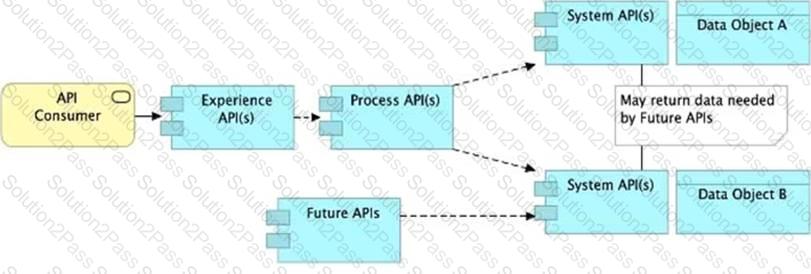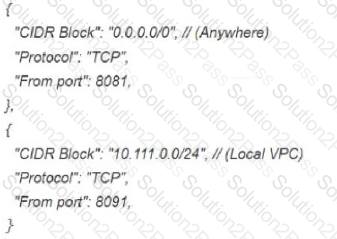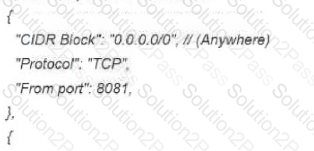MCPA-Level-1 MuleSoft Certified Platform Architect - Level 1 Free Practice Exam Questions (2025 Updated)
Prepare effectively for your MuleSoft MCPA-Level-1 MuleSoft Certified Platform Architect - Level 1 certification with our extensive collection of free, high-quality practice questions. Each question is designed to mirror the actual exam format and objectives, complete with comprehensive answers and detailed explanations. Our materials are regularly updated for 2025, ensuring you have the most current resources to build confidence and succeed on your first attempt.
Which statement is true about identity management and client management on Anypoint Platform?
A system API has a guaranteed SLA of 100 ms per request. The system API is deployed to a primary environment as well as to a disaster recovery (DR) environment, with different DNS names in each environment. An upstream process API invokes the system API and the main goal of this process API is to respond to client requests in the least possible time. In what order should the system APIs be invoked, and what changes should be made in order to speed up the response time for requests from the process API?
A large organization with an experienced central IT department is getting started using MuleSoft. There is a project to connect a siloed back-end system to a new
Customer Relationship Management (CRM) system. The Center for Enablement is coaching them to use API-led connectivity.
What action would support the creation of an application network using API-led connectivity?
Refer to the exhibit.
What is the best way to decompose one end-to-end business process into a collaboration of Experience, Process, and System APIs?
A) Handle customizations for the end-user application at the Process API level rather than the Experience API level
B) Allow System APIs to return data that is NOT currently required by the identified Process or Experience APIs
C) Always use a tiered approach by creating exactly one API for each of the 3 layers (Experience, Process and System APIs)
D) Use a Process API to orchestrate calls to multiple System APIs, but NOT to other Process APIs

An API has been updated in Anypoint exchange by its API producer from version 3.1.1 to 3.2.0 following accepted semantic versioning practices and the changes have been communicated via the APIs public portal. The API endpoint does NOT change in the new version. How should the developer of an API client respond to this change?
A client has several applications running on the Salesforce service cloud. The business requirement for integration is to get daily data changes from Account and Case
Objects. Data needs to be moved to the client's private cloud AWS DynamoDB instance as a single JSON and the business foresees only wanting five attributes from the
Account object, which has 219 attributes (some custom) and eight attributes from the Case Object.
What design should be used to support the API/ Application data model?
Once an API Implementation is ready and the API is registered on API Manager, who should request the access to the API on Anypoint Exchange?
True or False. We should always make sure that the APIs being designed and developed are self-servable even if it needs more man-day effort and resources.
An existing Quoting API is defined in RAML and used by REST clients for interacting with the quoting engine. Currently there is a resource defined in the RAML that allows the creation of quotes; however, a new requirement was just received to allow for the updating of existing quotes.
Which two actions need to be taken to facilitate this change so it can be processed?
Choose 2 answers
Which statement is true about Spike Control policy and Rate Limiting policy?
An API with multiple API implementations (Mule applications) is deployed to both CloudHub and customer-hosted Mule runtimes. All the deployments are managed by
the MuleSoft-hosted control plane. An alert needs to be triggered whenever an API implementation stops responding to API requests, even if no API clients have called the API implementation for some time.
What is the most effective out-of-the-box solution to create these alerts to monitor the API implementations?
To minimize operation costs, a customer wants to use a CloudHub 1.0 solution. The customer's requirements are:
* Separate resources with two Business groups
* High-availability (HA) for all APIs
* Route traffic via Dedicated load balancer (DLBs)
* Separate environments into production and non-production
Which solution meets the customer's needs?
4 Production environment is running on a dedicated Virtual Private Cloud (VPC) on CloudHub 1,0, and the security team guidelines clearly state no traffic on HTTP.
Which two options support these security guidelines?
Choose 2 answers
What Mule application deployment scenario requires using Anypoint Platform Private Cloud Edition or Anypoint Platform for Pivotal Cloud Foundry?
What is typically NOT a function of the APIs created within the framework called API-led connectivity?
An Order API triggers a sequence of other API calls to look up details of an order's items in a back-end inventory database. The Order API calls the OrderItems process API, which calls the Inventory system API. The Inventory system API performs database operations in the back-end inventory database.
The network connection between the Inventory system API and the database is known to be unreliable and hang at unpredictable times.
Where should a two-second timeout be configured in the API processing sequence so that the Order API never waits more than two seconds for a response from the Orderltems process API?

What should be ensured before sharing an API through a public Anypoint Exchange portal?
A new upstream API Is being designed to offer an SLA of 500 ms median and 800 ms maximum (99th percentile) response time. The corresponding API implementation needs to sequentially invoke 3 downstream APIs of very similar complexity.
The first of these downstream APIs offers the following SLA for its response time: median: 100 ms, 80th percentile: 500 ms, 95th percentile: 1000 ms.
If possible, how can a timeout be set in the upstream API for the invocation of the first downstream API to meet the new upstream API's desired SLA?
Version 3.0.1 of a REST API implementation represents time values in PST time using ISO 8601 hh:mm:ss format. The API implementation needs to be changed to instead represent time values in CEST time using ISO 8601 hh:mm:ss format. When following the semver.org semantic versioning specification, what version should be assigned to the updated API implementation?
A system API is deployed to a primary environment as well as to a disaster recovery (DR) environment, with different DNS names in each environment. A process API is a client to the system API and is being rate limited by the system API, with different limits in each of the environments. The system API's DR environment provides only 20% of the rate limiting offered by the primary environment. What is the best API fault-tolerant invocation strategy to reduce overall errors in the process API, given these conditions and constraints?



